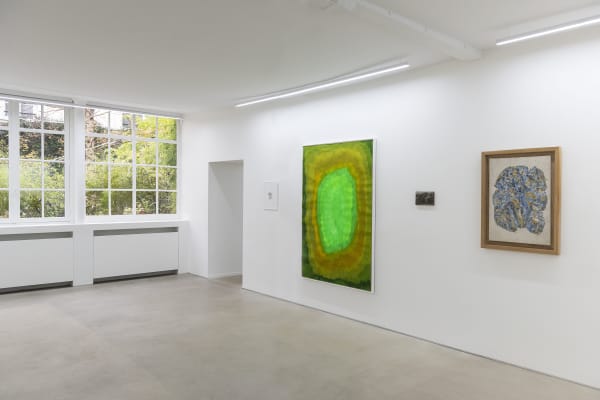« La relique est la première forme d’exposition »
Successivement, elle co-créer La Maison Auriolles en 2018 à Bias (sud-ouest de la France), lieu de recherche, de rencontres et d’inventions poétiques.
Aurélia Zahedi maquille la mort, la déguise pour la donner en spectacle. Elle est dans une quête incessante de sa beauté qu’elle met en avant par des artifices. Ses installations/sculptures qu’elle définit comme « pièges à séduction » laissent place à des memento mori.
Dans cette quête incessante elle multiplie ses voyages à Jéricho (Palestine). Ainsi, elle convoque un certain nombre dematières et de langages pour réinventer ce végétal poétique, qui dès lors, frôle des questions complexes de croyances et d’incertitudes. En 2018, elle obtient le Prix Nopoto pour La Rose de Jéricho puis en 2021, elle reçoit la bourse Fanak Fund pour la mobilité des artistes au Moyen-Orient, et la bourse Ekphr@sis de l’ADAGP.
En 2024, l’Institut des Cultures d’Islam à Paris expose une monographie de son travail sur la Rose de Jéricho.
-

LES DÉSERTEURS
BAS JAN ADER | MARIE BRACQUEMOND | GUSTAVE COURBET | SALVADOR DALÍ | QUENTIN DEROUET | SIMON HANTAÏ | VICTOR HUGO | JACQUELINE LAMBA | ROBERT MALAVAL | FLORA MOSCOVICI | OLIVIER MOSSET | GEORGES RIBEMONT-DESSAIGNES | JULIETTE ROCHE | MATHILDE ROSIER 5 Décembre 2024 - 11 Janvier 2025BAS JAN ADER | MARIE BRACQUEMOND | GUSTAVE COURBET | SALVADOR DALÍ | QUENTIN DEROUET | SIMON HANTAÏ | VICTOR HUGO | JACQUELINE LAMBA | GHERASIM LUCA | ROBERT MALAVAL...Lire plus -

L'AVENTURE, CROQUEFRUIT
QUENTIN DEROUET 1 Mai - 8 Juin 2024ERIC BAUER | HANS BELLMER | VICTOR BRAUNER | ISABELLE DAËRON | MATHILDE DENIZE | OSCAR DOMINGUEZ | MARCEL DUCHAMP | AUBE ELLÉOUËT | JACQUES HÉROLD | IDOINE | JACQUELINE...Lire plus
Mettre en lumière
Après ma première nuit à Maison Auriolles, un centre de recherche co-fondé en 2018 par l’artiste Aurélia Zahedi, j’ai trouvé un mot sur la table de la cuisine écrit sur papier rose : « Je suis allée jouer de l’orgue. De retour à 9h30. » Comme Zahedi m’avait vanté l’énergie vitale du Lot, rivière accessible par un
petit chemin depuis la propriété ancienne qui accueille le centre, j’avais décidé d’y plonger. Plus tard dans son atelier, avec une tasse de verveine de son jardin dans les mains, Zahedi m’a expliqué que pratiquer l’orgue dans les églises environnantes, dont elle détient les clefs, c’est ça son petit déjeuner. Elle est attirée par cet instrument auquel on ne peut jouer qu’après une ascension à l’intérieur des nefs de pierre et par sa musique « qui accompagne les morts. » Parcourant les claviers avec ses mains et ses pieds, elle voit s’ouvrir les portes de son cerveau.
lumière », à la manière de Jean-Henri Fabre. Elle se réfère parfois au naturaliste, philosophe et poète du 19e siècle, connu pour son travail méticuleux associé à une grande liberté d’interprétation, comme par exemple sur certains anthropoïdes comme le scarabée sacré. Inspirée par son attention, sa discipline du regard et sa capacité d’observer et de dépeindre, Zahedi dit « c’est ça être artiste : raconter une histoire ». Dans ses œuvres comme Madame le Sanglier (2015) où un crâne de l’animal est posé sur une colonne habillée en tissu rouge scintillant ou alors dans Danse macabre (2014) où une branche d’arbre morte est ornée avec des carcasses de pigeons, nous voyons l’artiste créer des personnages pour ses contes fantastiques.
A propos dʼAurélia ZAHEDI
« On entre dans une installation dʼAurélia Zahedi comme dans LʼEscarpolette de Fragonard, et on en ressort comme des caprices de Goya… « Je tiens à une première approche de séduction, provoquée par le merveilleux dans lʼimage, qui laisse place à une plus sombre amertume » reconnaît-elle. De loin tout nʼest que fleurs, danse, paillettes, mais de près ce sont des cadavres dʼanimaux et les souvenirs funéraires qui sautent à la gorge. Aurélia Zahedi revendique crânement la pratique artistique comme fabrique dʼillusions, de pièges à sentiments, mais à lʼapproche ses compositions cèdent la place à des décompositions, avatars contemporains des natures mortes ou des vanités dans La société du spectacle.
Tout ce qui, dans la peinture ancienne, chatoyait ou étincelait les compositions florales, le vernis, les flancs argentés de poissons à écailles, est étalé là, bien réel, sous nos yeux, sous notre nez aussi, putride, graisseux… Son Tapis de fleurs (2012) mêle vraies et fausses fleurs, mais toutes ont été ramassées au cimetière, et empestent soit la vieille poussière, soit le pourri. Idem pour sa gracile Danse macabre (2013) : foin dʼinsouciants volatiles sur la branche, car lʼarbre et les pigeons sont pareillement morts, et même momifiés. Le monde que nous promet Aurélia Zahedi est le nôtre, un monde en putréfaction qui se maquille outrageusement comme une courtisane fanée, mais ne parvient pas à dissimuler les os qui percent sous sa joue car elle nʼest plus quʼun squelette. »
— Stéphane Corréard, critique d’art, directeur du salon Galeristes,
ancien directeur du Salon de Montrouge à Paris.








